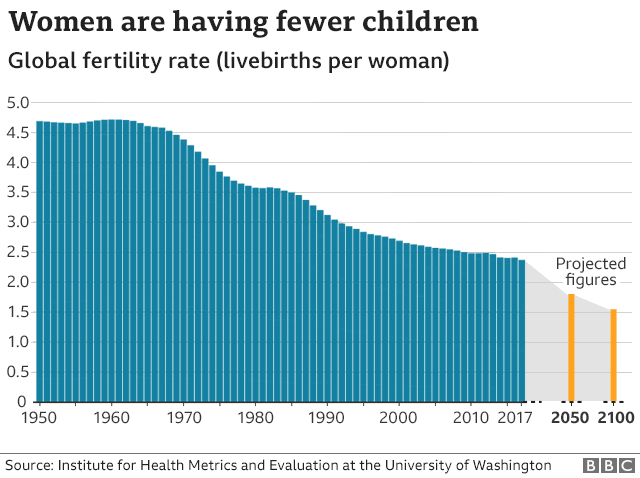
Declining Fertility Rate
Subscribers of "Current Affairs" course can Download Daily Current Affairs in PDF/DOC
Subscribe to Never Miss an Important Update! Assured Discounts on New Products!
Must Join PMF IAS Telegram Channel & PMF IAS History Telegram Channel
- Context (IE): According to the Lancet study, India’s total fertility rate (TFR), the average number of children born per woman, is dipping irreversibly to 1.29, far lower than the replacement rate of 2.1.
- The study was based on the Global Burden of Diseases, Injuries, and Risk Factors Study 2021, a research effort led by the Institute for Health Metrics and Evaluation at University of Washington.
Global Fertility Rate Trends
- During the period from 1950 to 2021, global TFR more than halved, from around five children for each woman in 1950 to 2.2 children in 2021.
- Future fertility rates were projected to continue to decline worldwide, reaching a global TFR of 1·83 in 2050 and 1·59 in 2100.

- The two nations projected to have the lowest predicted fertility rates in 2050 are Puerto Rico (0.84) and South Korea (0.82).
- The distribution of live births worldwide is shifting, with a greater proportion occurring in the lowest-income countries.
- In 1950, one-third of the global live births occurred in Southeast Asia, East Asia, and Oceania.
- However, this concentration has shifted to the sub-Saharan African region, which, after 2011, accounted for the largest share of live births — increasing from 8 percent in 1950 to nearly 30 percent by 2021.
- Change in the distribution of live births will result in a “demographically divided world” where high-income nations will have to deal with the effects of an ageing population and a shrinking workforce, while low-income areas will struggle with high birth rates and resource constraints.
- The proportion of live births in low-income areas worldwide will almost quadruple from 18% in 2021 to 35% in 2100.
- By 2100, one out of every two children born will be born in sub-Saharan Africa alone.
- The GBD report says that by 2050, fertility rates in three-quarters of all countries will not be high enough to support population growth.
- In India, the TFR was 6.18 in 1950, which reduced to 4.60 in 1980 and further declined to 1.91 in 2021.
- China is already dealing with the demographic disadvantage of an ageing population. India, too, is heading in that direction. These two nations together account for more than a third of the world’s population.
Reasons for declining fertility rate
Decline in Infant mortality
- Various maternal and child health-related programmes, like the Family Welfare Programme, including maternal and child health-related cash transfer inducements and successful immunisation in India, guaranteed child survival, giving rise to small families.
Economic dimension
- With development, the inter-generational flow of wealth has reversed. “This means parents now do not receive as much benefit from their children as they used to.
- This has influenced the decision to have an additional child, which would involve a substantial cost of raising them.
Women empowerment
- The rise of female literacy and women’s participation in the workforce. Career consciousness, financial returns, and economic independence have meant that women are reconsidering their options for having a second child.
- In the urban space, many women do not consider child-rearing as a must-do task; they are instead choosing not to have babies at all and even considering options like adoption. This pattern is percolating in rural India, too.
Long-term consequences of declining fertility rates
- Low levels of fertility have the potential over time to result in inverted population pyramids with growing numbers of older people and declining working-age populations.
- Sustained low fertility rates might likewise lead to labour shortages in some sectors, potentially hindering economic growth.
- Reliance on immigrants will become increasingly necessary to sustain economic growth in low-fertility countries.
- Continued skilled worker migration to high-income, low-fertility economies—a concept referred to as brain drain—can also have devastating effects on the economies these workers leave behind.
- Increase the burden on health care and social systems, transform labour and consumer markets, and alter patterns of resource use.




![PMF IAS Environment for UPSC 2022-23 [paperback] PMF IAS [Nov 30, 2021]…](https://pmfias.b-cdn.net/wp-content/uploads/2024/04/pmfiasenvironmentforupsc2022-23paperbackpmfiasnov302021.jpg)











